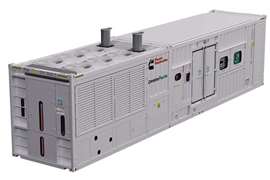Read this article in Français Deutsch Italiano Português Español
Gen-set maker partners to add engines
16 September 2024
Partnership with HDI is enabling Mesa Solutions to expand its portfolio beyond gaseous-fueled generators.
From a historical perspective, 10 years may seem like a drop in the bucket to those active in the power generation industry. Yet, a lot can be accomplished in a decade. Just ask Mesa Solutions, an energy services provider headquartered in Loveland, Colo., and specializing in the manufacture, sale, rental and lease of portable gaseous-fueled power solutions.
 Under the partnership agreement, HDI supplies the long blocks for the engines while Mesa does the “dressing out.” (Photo: Mesa Solutions)
Under the partnership agreement, HDI supplies the long blocks for the engines while Mesa does the “dressing out.” (Photo: Mesa Solutions)
Since its start in 2014, Mesa has deployed more than 2,000 generator sets to over 130 customers, generating 450+ MW of power for commercial and industrial prime power, microgrid, standby power and other applications. And now, following an announcement at ConExpo-Con/Agg 2023 of its partnership with global construction equipment and engine manufacturer Hyundai Doosan Infracore (HDI), Mesa is set to distribute its own line of gaseous-fueled engines.
“In terms of business development growth, we’re a young company. We’ve evolved from building our own natural gas generators to doing different facets of the industry, whether it’s standby power or emergency response,” said Tom Poteet, vice president, Corporate Development, Mesa Solutions. “Now, we’re getting into the development and release of engine lines through our partnership with Hyundai.”
‘The 800-lb. Gorilla’ in Leased Power
Mesa has been immersed in the oil and gas industry from its beginnings in 2014, when late oil and gas magnate and financier Thomas Boone Pickens Jr. helped found Mesa Natural Gas Solutions. The company was one of the first startups funded by BP Energy Partners, an energy private equity fund.
Initially, plans called for a related company to produce the natural gas gen-sets it would market, but Poteet said Mesa quickly “outgrew them” and began its own production out of a 90,000-sq.-ft. facility in Casper, Wyo. “We enhanced the design, had components come to us and we started assembly and production. We now have thousands of units deployed on rent,” he said.
As of mid-2023, the company is wholly owned by Arroyo Investors, a Houston-based independent investment manager focused on power generation and energy infrastructure assets. It now operates as Mesa Solutions.
 The GV22PU is a 22 L, V12, turbocharged and intercooled engine rated up to 684 hp at 60 Hz or 606 hp at 50 Hz. (Photo: Mesa Solutions)
The GV22PU is a 22 L, V12, turbocharged and intercooled engine rated up to 684 hp at 60 Hz or 606 hp at 50 Hz. (Photo: Mesa Solutions)
Gen-sets are available in five output sizes from 70 to 350 kW. They can utilize a range of gaseous fuels, including natural gas, liquid propane, wellhead gas, coal-bed methane, renewable natural gas and some liquefied petroleum gases. Different form factors of each model are available, with trailer-mounted units the most popular for oilfield applications.
According to Mesa, its gen-sets are designed to offer a flexible method of flare mitigation to oil and gas operators, advanced catalytic control options and compatibility with renewable energy. This flexibility has helped Mesa become a leading North American provider of 24-7 portable power solutions utilizing wellhead natural gas.
In terms of leased power in the oilfields, Poteet said Mesa is now “the 800-lb. gorilla in the industry because of the quality and reliability of the machines we produce and because of the level of service and support we can provide.”
“In the oilfield, there’s only one spec and that’s ‘Is the [generator] running or not – because if it’s not, we need you to come move it because your competitor needs that spot.’ So that business environment has driven us to a very, very efficient and reliable overall design of our generator,” he stated. “And it’s driving us in the standby market.”
From Engine Buyer to Engine Partner
“About the time the shale plays were taking off, around 2011, was also about the time that engine companies like Doosan (now HDI) were perfecting engine blocks for natural gas,” Poteet noted. “Oil companies saw the benefit, because if they could have generators on site that burn gas from the shale field, it eliminated the need to build a line or transport fuel to the site.”
Mesa originally secured its engines from one of HDI’s then-suppliers, and quickly grew to become one of its largest customers for natural gas engines. The original spec for the 22 L GV22 gen-set engine used in its largest gen-set was 700 to 2,500 btu, which Poteet put in perspective by comparing this to the roughly 1,000 btu for the average home.
To meet the demands of oilfield customers, Mesa made some important modifications. “The fluctuation in level within the fuel required the engines to be a little stronger and for the software/electronic control unit to be able to modulate the engine to changes up to 2,500 btu. That is also the level for propane, which means that the engines can burn propane, as well,” he pointed out.
Understanding the Veterans’ Mindset
There is a strong sense of pride when Mesa Solution team members speak about the company’s military ties. At PowerGen International 2024, it was one of the first things mentioned about the company as you stepped into the booth.
“We have some of the guys in our top brass that are former military – veteran owned through and through. And we take pride in going after and doing things the right way, and the best way, that we can find how to build,” said Mesa’s Tom Poteet. “No is never an answer; the answer is there’s an obstacle that we need to figure out how to overcome.
“At the same time, environmentally sound, responsible, reliable power is kind of our credo here,” he added.
Having employees who share the same drive and sense of purpose has proven essential to the company’s growth, with military veterans seen as a natural fit. So, the company made an active commitment to hire and support veterans and their families.
Its efforts earned Mesa the 2017 Secretary of Defense Employer Support Freedom Award for its support for National Guard members and reservists; the Honoring Investments in Recruiting and Employing American Military Veterans (HIRE Vets) Medallion Award (Platinum); and the ESGR’s Extraordinary Support Award for sustained employer support of National Guard members and reservists – with the latter two awarded annually for several years running.
“The company is so successful [in hiring veterans] because they have a native understanding of what goes into military service and the skills and preparation that went into it,” Poteet stated. “They understand veterans’ way of thinking and the way they want to just get the work done, and get it done right.”
Two different intakes are used, with automatic switching between fuel types (natural gas, wellhead gas, propane, CNG or LNG). “We really distinguished ourselves by being able to switch between fuels without dropping the load,” Poteet said.
When HDI decided to make a supplier change, Poteet said, “They came to us and said they had engine design enhancements, and they wanted to have Mesa take over as their engine supplier.” The result was the partnership agreement formally announced at ConExpo 2023.
Under the agreement, HDI supplies the long blocks for the engines while Mesa does the “dressing out.” This includes incorporating Mesa’s in-house developed engine control module, fuel regulator, throttle, as well as other key components. Securing Environmental Protection Agency (EPA) certification also falls on Mesa’s shoulders.
“[We act as a packager] but we also have improved the throttle apparatus over what it was before. We improved the cylinders and cylinder heads over the previous product,” Poteet pointed out.
“The desire was born to build a bigger and better mousetrap. We take these engines, look at the applications… and the environments that we put them in,” he continued. “We’re always detailing the small failures that you would find in a normal, typical engine platform and how can we get around this and make the experience better for the end user.”
A New World Opens Up
The first of the engines to achieve EPA certification is the GV22PU, a 22 L, V12, turbocharged and intercooled engine that replaces the original GV22. The GV22PU has bore x stroke dimensions of 128 mm x 142 mm and is rated up to 684 hp (510 kW) at 60 Hz or up to 606 hp (452 kW) at 50 Hz, depending on fuel type. This a power increase of more than 20% over the prior engine.
With EPA certification, Poteet said, “We can not only use the engines internally, we can now sell them to customers, as well. We can take those engines and our generator customers will benefit because now there’s no middleman. But it’s also opened up a whole new world for us of just selling engines.”
Features that Mesa incorporated into the GV22PU include a new throttle, a modified intake design and an updated knock sensor calibration to enhance performance by refining the combustion process.
 All the new engines will be certified based on both pipeline natural gas and propane and tested from 700 to 1,800 btu. (Photo: Mesa Solutions)
All the new engines will be certified based on both pipeline natural gas and propane and tested from 700 to 1,800 btu. (Photo: Mesa Solutions)
The new throttle and electronic fuel regulator are designed to enable more precise air and fuel flow for improved combustion and throttle response, while the modified intake design reduces air resistance and improves cylinder to cylinder distribution for more power and overall efficiency, Mesa stated. The updated knock sensor quickly detects and mitigates engine knock to optimize performance.
The next step for the company will be to secure EPA certification for the GX Series engines, which will be offered in 11.1 L, 14.6 L and 21.9 L displacements in I-6, V8 and V12 configurations, respectively. The series will utilize a four-valve cylinder head in place of the two-valve configuration, which Mesa said provides a stronger cylinder head for greater strength and durability, plus a higher power density due to increased cylinder pressure.
All the new engines will be certified based on both pipeline natural gas and propane and tested from 700 to 1,800 btu. Production will take place at the Casper facility.
Shifting Market
In addition to natural gas variants, HDI is developing an engine block that works with hydrogen to meet industry interest in the use of this zero-emission fuel. A non-functioning version of a 402-hp (300 kW), inline six-cylinder, 11.1 L hydrogen engine was shown in the Mesa booth at PowerGen International earlier this year, but functioning versions are in development and being put out on test.
 Mesa offers gen-sets in five output sizes from 70 to 350 kW, which are capable of utilizing a range of gaseous fuels. (Photo: Mesa Solutions)
Mesa offers gen-sets in five output sizes from 70 to 350 kW, which are capable of utilizing a range of gaseous fuels. (Photo: Mesa Solutions)
“Mesa is working with HDI on the development of the hydrogen engine into a gen-set and anticipates the trial unit to be complete in late 2025 or early 2026,” Poteet said.
Mesa is seeing other market shifts beyond fuel types, including more demand for long-term leases for its gen-sets and even a move toward purchase in place of rental or lease.
“As we’ve gotten bigger and had more volume and velocity as a company, we have been pushing more to sales of generators. In the last three to four years, we’ve ramped up our sales and are getting some large purchase orders,” Poteet stated.
Data Centers Move to Microgrids
This shift has resulted in Mesa selling a growing number of generators, including microgrid systems, to countries around the globe.
“Currently, our rental fleet size, we go anywhere from 75 kW up to 350 kW, but then you can parallel those in sequence to a larger capacity,” said Poteet. “The two largest models are the ones that are most easily paralleled, with the 350-kW model most readily used in this configuration.”
 A non-functioning version of a Hyundai hydrogren engine was shown in the Mesa book at PowerGen International. (Photo: KHL Staff)
A non-functioning version of a Hyundai hydrogren engine was shown in the Mesa book at PowerGen International. (Photo: KHL Staff)
Such microgrid-type solutions have become increasingly popular among customers like data centers, which require a “ton of power,” Poteet said. Such customers used to install megawatts of power in a few generators, he noted, but now they’re turning more to multiple smaller generators, where the footprint allows.
The use of multiple generators in parallel enables power to be broken up into blocks for greater energy reliability. For example, consider twenty 350-kW generators working in parallel to produce roughly 10 MW of power versus three 3-MW diesel generators. If a single 3-MW generator were to fail, it would have a major impact on available power, Poteet pointed out. “If you lose one of 20 generators, it’s less of an impact.”
Expanding Reach
Mesa Solutions plans to continue to expand its reach in these and other applications and markets, and it looks forward to the ongoing expansion of its engine lineup and the sales opportunities this will provide. But there is one shift it does not plan to make anytime soon.
“We’re now getting into commercial and industrial standby and utility applications,” Poteet noted. “But we’ll still be marketing to the oilfields for a very long time.”
POWER SOURCING GUIDE
The trusted reference and buyer’s guide for 83 years
The original “desktop search engine,” guiding nearly 10,000 users in more than 90 countries it is the primary reference for specifications and details on all the components that go into engine systems.
Visit Now
STAY CONNECTED




Receive the information you need when you need it through our world-leading magazines, newsletters and daily briefings.
CONNECT WITH THE TEAM















